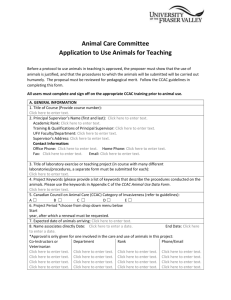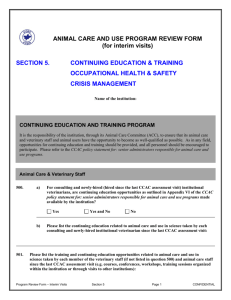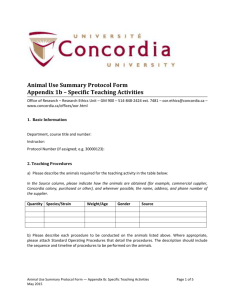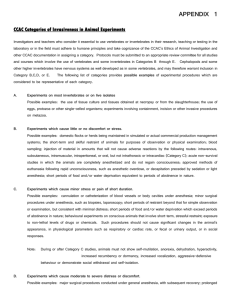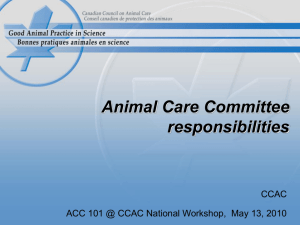INSTRUCTIONS FOR COMPLETION OF THE CCAC ANIMAL USE DATA FORM (AUDF)
advertisement
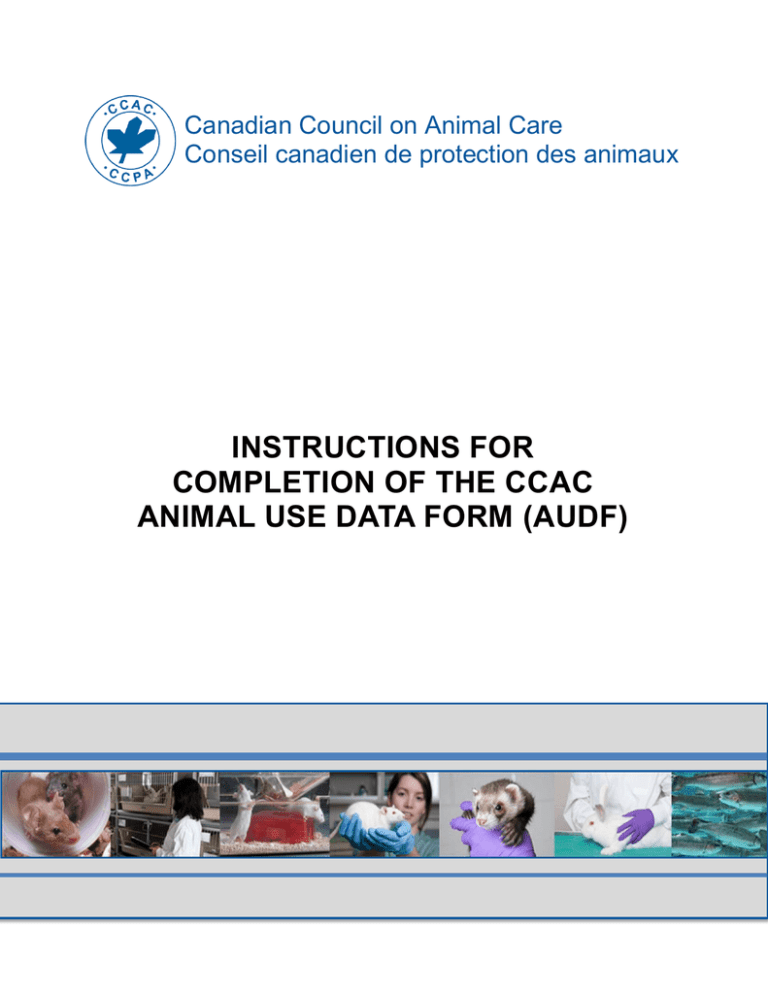
Canadian Council on Animal Care Conseil canadien de protection des animaux INSTRUCTIONS FOR COMPLETION OF THE CCAC ANIMAL USE DATA FORM (AUDF) i TABLE OF CONTENTS A. PREAMBLE ....................................................................................................................... 1 B. INTRODUCTION ................................................................................................................ 1 C. ANIMALS TO BE INCLUDED ON THE AUDF ................................................................... 2 D. REQUIRED ELEMENTS .................................................................................................... 3 APPENDIX A CCAC AUDF TEMPLATE .......................................................................................................... 7 APPENDIX B CATEGORIES OF INVASIVENESS ........................................................................................... 8 APPENDIX C EXAMPLE KEYWORDS ............................................................................................................ 9 APPENDIX D PURPOSE OF ANIMAL USE .................................................................................................................11 APPENDIX E EXAMPLES ...............................................................................................................................................13 i INSTRUCTIONS FOR COMPLETION OF THE CCAC ANIMAL USE DATA FORM (AUDF) A. PREAMBLE Publication of animal use data is important to provide accountability for the use of animals to the Canadian public, and to contribute to a better understanding of scientific animal use in Canada. The CCAC has been publishing national surveys of animal use in science since 1975. The complete results and analysis from these surveys are available from 1996 onward on the CCAC website. The CCAC Animal Use Data Form (AUDF) allows the CCAC to collect information on animal use in science. The CCAC uses the information from the AUDF to prepare the national surveys of animal use. The surveys present aggregate information (individual institutions are not identified) on the numbers of animals used per genus and species, the purpose of animal use (PAU) and the degree of invasiveness of the procedures used on the animals. Analysis of the AUDF data provides valuable information for assessment visits, guideline and policy development, and education and Three Rs activities. The Instructions for completion of the CCAC Animal Use Data Form (AUDF) aims to provide information and assistance to CCAC constituents in filling out the AUDF. As the CCAC works to improve the collating and reporting of animal use in science, this document will be revised. The most current version will be available on the CCAC website and will accompany the annual request for submission of data sent to CCAC program participants. B. INTRODUCTION Participants in the CCAC program are required to submit all of their animal use data for a calendar year by March 31st of the following year as stated in Section 5c of the CCAC policy statement on: terms of reference for animal care committees. Institutions are requested to submit their animal use information using the CCAC AUDF MS Excel template format provided on the CCAC website (or compatible software such as CSV). This document describes and explains each element to be completed on the AUDF. It provides answers to some frequently asked questions and examples on how to submit animal use data. In cases where two or more institutions are involved in an animal-based project, in general, it is the responsibility of the host institution only (i.e. the institution where the animals are located), to report the number of animals used. This responsibility should be clarified with all of the partners prior to the start of the project. The CCAC staff reviews and validates all institutional AUDF submissions to ensure that the composite data is as accurate as possible. If there are any questions concerning missing data or inconsistencies, the institution will be contacted to request additional information. A prompt response is appreciated as it assists the CCAC to publish the animal use data in a timely manner. If any of the data is re-classified by Page | 1 the CCAC, the amendments will be communicated to the institution to ensure that institutional records are consistent with the CCAC dataset. C. ANIMALS TO BE INCLUDED ON THE AUDF Protocols All vertebrates and cephalopods used for research, teaching or testing, or for display purposes or eventual use in research, teaching or testing must be the subject of a written animal use protocol to be approved by the institutional ACC. However, not all animals need to be included on the AUDF. Please refer to the following lists indicating which animals should be reported to the CCAC. Animals Included on the AUDF All vertebrates (including fish) used for research, teaching or testing Cephalopods (octopus and squid) used for research, teaching or testing Animals held, even for a short period, if assigned to a protocol (see exceptions below) Mammals which are tagged in studies that involve some sort of restraint and the taking of measurements or tissue samples Fish that are fitted with transmitters Animals involved in lethal field sampling for research, teaching or non-routine testing purposes (not including lethal field sampling for population management and monitoring programs) Animals that are used outside of Canada by Canadian scientists, who have submitted an animal use protocol form for these animals to their institutional animal care committee Animals Not Included on the AUDF All animals assigned to category of invasiveness A (see Appendix B) All invertebrates other than cephalopods All dead animals that were not killed specifically for a protocol (e.g., use of tissue culture and tissues obtained at necropsy or from the slaughterhouse) Eggs, embryos, fetuses, larvae (except for fish and amphibian larvae that have reached a stage where survival can reasonably be expected) Animals observed where there is no manipulation or interference of any kind, (e.g., field studies) Animals held in breeding colonies under a breeding protocol and which have not been assigned to a particular research, teaching or testing protocol Animals cared for through routine husbandry (except for teaching purposes) under a herd management protocol Page | 2 D. Privately owned animals should not be reported on the AUDF if the primary reason for seeing them is for medical reasons, and not for training opportunities for students1. Animals which have already been killed as the result of standard commercial practices Hatchery fish reared for release, unless specifically used in experiments or displays; Fish involved in mark/recapture studies for abundance estimates, migration, and other parameters required for assessing stocks Fish counted at installations such as counting fences and traps Fish which are lethally sampled for fish inspection procedures (e.g. trawling, gill netting) Fish used for abundance estimates or to measure other population parameters required for assessing stocks and for monitoring contaminant/toxin levels and disease Sentinel animals Animals used as source of food for other animals Teasers (teaser bitches for collecting semen) REQUIRED ELEMENTS The following eight (8) fields must be completed on the AUDF while the ninth field is optional (an example of a blank form is shown in Appendix A): 1) Unique protocol number 2) Category of invasiveness (CI) 3) Protocol description and/or keywords 4) Purpose of animal use (PAU) 5) Animal genus and species 6) Number of animals used in the calendar year of submission 7) Number of animals reused from protocols within the calendar year of submission 8) For reused animals, protocol number of first use Optional Information: 9) Number of animals reused from protocols from a previous calendar year 1 Client animals brought into a Veterinary College or an external veterinary clinic are primarily there for veterinary care, and even though students sometimes use these animals as part of their educational training - these animals should not be reported on the AUDF. However, some colleges with a Veterinary Technician program have clinics that are used exclusively as teaching clinics. Animals seen in a teaching clinic, although provided with veterinary care, are primarily used to train students in the Veterinary Technician program. Therefore, these animals should be reported on the AUDF. Page | 3 1) Unique Protocol Number Institutions attribute a unique number to each protocol for ease of reference and follow-up of activities. Identification of the protocol is particularly important for pre-assessment purposes since panel members visiting the institution may wish to review a particular protocol or it may be necessary to identify a protocol for comments in the assessment report. It also assists the CCAC to follow up with an institution where any errors or omissions are noted in the submission. This information is not published in CCAC annual surveys of animal use. 2) Category of Invasiveness CIs are to be assigned according to the CCAC policy statement on: categories of invasiveness in animal experiments (1991) (see Appendix B) or to CCAC Categories of Invasiveness for Wildlife Studies (see Appendix B) for field studies. A protocol must be assigned a CI (A to E) before it is approved by the institutional ACC (Section 3c of the CCAC policy statement on: terms of reference for animal care committees). CCAC CIs are based on a precautionary approach and protocols are assigned a CI according to the potential level of pain and distress that the animals might experience. Protocols assigned a level A of invasiveness are not published in the annual CCAC surveys of animal use. CI A is assigned where protocols involve the use of tissue, tissue culture, eggs, invertebrates, protozoa or other animal use where neither vertebrates nor cephalopods are involved. However, if protocols involve the use of tissue from animals that have been euthanized specifically to collect these tissues, then a level B of invasiveness should be assigned and the number of animals euthanized must be reported on the AUDF. For examples of the level of invasiveness to assign to commonly used procedures, refer to Appendix B. 3) Protocol Description and/or Keywords The use of the protocol description and/or keywords helps to validate the animal use data. The protocol description should be brief (about 40 words or less). It must convey, in simple terms, the PAU and clearly relate to the CI. For protocol descriptions for PAU 3 (regulatory testing) it is useful to include the name and/or number of the specific regulatory test that is being conducted2. In addition, field studies must be identified as such. The keywords should similarly relate to the assigned PAU and should describe the procedures used, indicative of the assigned CI. This information is not published in CCAC annual surveys of animal use. For examples of keywords of commonly used procedures, refer to Appendix C. 2 This assists the CCAC to identify any potential alternative methods that have been validated and accepted for regulatory use. Page | 4 4) Purpose of Animal Use The CCAC PAUs are divided into six specific categories: PAU 0: breeding colonies, herd management and holding protocols3 PAU 1: fundamental studies PAU 2: medical studies, including veterinary medicine PAU 3: regulatory testing PAU 4: development of products PAU 5: educational purposes PAU should be assigned according to the primary purpose of the study. For examples of purpose of use categories to assign to types of animal studies commonly conducted, refer to Appendix D. 5) Animal Genus and Species All animals must be clearly identified by genus and species. Common species names that distinguish species may be used, but general categories, such as “fish”, "avian", "small mammals", "various amphibians", "wild rodents", "poultry", or "farm animals", must not be used to identify animals. For example, zebrafish or salmon (not fish), zebrafinch or chicken (not bird), house mouse (to distinguish from deer mouse); domestic pig, (to differentiate from wild pig) etc. When different species are used within a single protocol (e.g., small mammals in field studies) each species must be reported on a separate line (see Table 3 in Appendix E for an example). Having institutions identify animal species: enables the CCAC to search its database to identify trends in animal use; helps the CCAC Guidelines Committee identify species on which to focus for the development of new guidelines; and contributes to public accountability for animals used in science. Cats and Dogs For protocols involving the use of cats and/or dogs, it must be specified on the AUDF whether the animals were acquired from a random source (i.e. were not bred specifically for research, teaching or testing, either by a commercial supplier or within your own or another institution; these animals are generally obtained from pounds or humane societies, or are the animals of students or clients) or whether they were purpose-bred (i.e. were bred specifically for research, teaching, testing, either by a commercial supplier or within your own or another institution). 3 In addition to PAU 1-5, CCAC has created a PAU 0. This category of PAU is useful to those institutions that report data to the CCAC on the number of animals being held in breeding colonies, herd management, or holding protocols that have not been assigned to a particular research, teaching or testing protocol. At the present time, CCAC does not require this data, but institutions may choose to include it on the AUDF. Page | 5 6) Number of Animals Used in the calendar year of submission This field must contain the number of animals used for each protocol between January 1st and December 31st of every year. In cases where the same animals are used in a protocol that spans over several years, their numbers should be reported on the AUDF each year. For some examples that illustrate how to submit animal use data, refer to Appendix E. 7) Number of Animals Reused from Protocols within the Calendar Year of Submission In the published CCAC animal use surveys, the absolute number of animals used may be: less than the sum of the number of animals used per PAU and less than the sum of the number of animals used per category of invasiveness. This is due to situations where the same animal is used in two or more protocols within a calendar year. To capture this information in the AUDF, when an animal is reused from another protocol within the same submission year, the number of reused animals must be entered in the appropriate AUDF column. This information will allow the CCAC to calculate the absolute number of animals used (i.e. number of uses minus re-use). Animals reused from a previous year should not be marked as re-use (see point 9 below). These animals are considered a new use for each current calendar year. For some examples that illustrate how to submit animal use data, refer to Appendix E. 8) For Reused Animals, Protocol Number of First Use If animals are reused in another protocol within the same calendar year, the original protocol number must be entered next to the number of animals that were reused. 9) Animals Reused from a Previous Year In some situations, particularly with larger mammals, individual animals are used a number of times over a period of several years in either single or multiple protocols. If applicable, institutions may choose to indicate on the AUDF when animals have been used in previous years. They may do this by adding a short descriptive comment (stating the number of years the animal has been used and the type of research) in the appropriate column in the AUDF template. For some examples that illustrate how to submit animal use data, refer to Appendix E. Page | 6 APPENDIX A CCAC AUDF TEMPLATE ANIMAL USE DATA FORM Institution Name: Year: A protocol may contain more than one purpose, species and/or level of invasiveness – animals used for different PAUs or at different CIs should be listed on separate lines within the same protocol. In the case of cats and dogs please also indicate source (random or purpose-bred) Unique Protocol Number CI Protocol Description Keywords PAU Animal Genus and Species Number of Animals Used Number of Animals Re-used Protocol Number of First Use OPTIONAL Re-used from Previous Year The CCAC PAUs are divided into six specific categories: PAU 0: Breeding colonies PAU 1: Fundamental studies PAU 2: Medical studies, including veterinary medicine PAU 3: Regulatory testing PAU 4: Development of products PAU 5: Educational purposes The CCAC CIs are divided into five specific categories: CI A: Experiments on most invertebrates or on live isolates CI B: Experiments which cause little or no discomfort or stress CI C: Experiments which cause minor stress or pain of short duration CI D: Experiments which cause moderate to severe distress or discomfort CI E: Procedures which cause severe pain near, at, or above the pain tolerance threshold of unanaesthetized conscious animals Page | 7 APPENDIX B CATEGORIES OF INVASIVENESS For examples of assigning CIs to animal-based procedures see: 1. CCAC policy statement on: categories of invasiveness in animal experiments 2. Appendix D Categories of invasiveness for wildlife studies in CCAC guidelines on: the care and use of wildlife (2003) 3. Answers to Frequently Asked Questions in relation to CI: a) Procedures that involve removing an appropriate amount of tissue from the tip of the tail of an animal to identify its genotype should be assigned a level B of invasiveness. b) Protocols involving oral gavage (tube feeding) should be assigned a level C of invasiveness. c) Protocols involving electrofishing should be assigned a level D of invasiveness. CCAC encourages institutions to use alternatives to electroshocking. d) Protocols where generation of a genetically-engineered animal involves creation of a novel genotype should be assigned a level D of invasiveness as stated in the section “Proposals to create new transgenic strains” of the CCAC guidelines on: transgenic animals (1997). Once the genetically-engineered animal is created, the CI assigned depends on the resulting phenotype and on the nature of procedures to be conducted on the animal. e) CIs are assigned differently for laboratory animals compared to those involved in wildlife and field studies. Please refer to the appropriate documents (see above) when assigning CI. Page | 8 APPENDIX C EXAMPLE KEYWORDS Please note these are provided as examples, there are no limitations on the use of keywords. Procedures Trapping/netting, marking/tagging, physical restraint (duration short or long-term), handling, physical exam Injection, vaccination (intravenous, subcutaneous, intramuscular, intraperitoneal, intrathoracic, intracardiac) Blood sampling, blood removal, blood collection, tail tip, genotyping Oral gavaging, infection induction Whole body radiation, Physical methods of euthanasia Castration, dehorning Food deprivation, water deprivation Altered environmental exposure Electrofishing Research Behavioural observation; field study Breeding, breeding colony, sentinel program Fundamental science Medical studies, veterinary studies, human disease, animal disease Regulatory testing, product testing, safety testing, regulatory toxicology, vaccine efficacy Product development, appliance development, (e.g. medical device, physical device, artifical organ Education, teaching, training Antibody production (monoclonal, polyclonal); primary cell culture, tissue/organ collection, graft, transplant Maternal deprivation, aggression, predator-prey interactions Genetically-engineered animal Validation of non-animal model (in vitro test, computational methods) Page | 9 Agents Radioisotope administration Noxious stimuli exposure Radiation Chemical exposure Infectious agents Immunogenic or inflammatory agents Freund's Complete Adjuvant (FCA) Surgery Major surgery Minor surgery Stereotaxic surgery Survival surgery Non-recovery surgery Non-survival surgery Multiple surgeries Cannulation Catherization Biopsy Laproscopy Anesthesia Analgesia Analgesia withholding Page | 10 APPENDIX D PURPOSE OF ANIMAL USE PAU 0 Breeding Colony/Stock PAU 1 Studies of a fundamental nature in sciences relating to essential structure or function Basic science studies, including biology, biochemistry, pharmacology, physiology). Studies for medical purposes, including veterinary medicine, that relate to human or animal diseases or disorders Studies carried out to better understand a specific disease or disorder and to help find therapies for it. Studies for regulatory testing of products for the protection of humans, animals, or the environment Studies required by government authorities. Studies for the development of products or appliances for human or veterinary medicine Studies carried out to investigate potential therapies (as determined following studies of PAU 2) for humans or animals, before regulatory testing (PAU 3) is carried out on the most promising therapies. PAU 2 PAU 3 PAU 4 Animals held in breeding colonies (e.g., fish, rodents, farm animals) that have not been assigned to a particular research, teaching or testing protocol. psychology, Examples: studies designed to understand the cellular and/or molecular basis of inflammatory reactions or other basic physiological or biochemical reactions; studies designed to understand one or some of the various facets of the role played by a hormone or other compound produced by mammals; studies designed to better understand the behavior of various species; studies designed to better understand the population dynamics of various species Examples: development of a mouse model for a specific type of cancer or other disease; studies to determine which antibodies are the most likely to contribute positively to the therapy of a specific type of cancer; studies to determine which molecule within a particular class of compounds is the most likely to contribute to maintaining stable blood glucose levels in an animal model of diabetes Examples: safety testing, regulatory toxicology, vaccine efficacy trials, and testing of new therapeutic compounds (if it is to generate data that is going to be used in a submission for an investigational new drug application (IND) or for a new drug application (NDA)); shellfish toxin testing Examples: studies undertaken in animals to investigate the role and effects of a specific drug or immunotherapy candidate for cancer; studies undertaken to develop physical devices to assist heart function; studies undertaken to develop artificial organs PAU 5 Education and training of individuals in postsecondary institutions or facilities Teaching or training programs where animals are used to introduce students to scientific work and teach manual skills and techniques. Page | 11 Answers to Frequently Asked Questions in Relation to PAU: a) Is it mandatory to include protocols assigned to PAU 0 in the AUDF submission? Currently, it is not mandatory to include protocols assigned to PAU 0, although submission is encouraged. This category of PAU is useful to those institutions that report data to the CCAC on the number of animals being held in breeding colonies that have not been assigned to a particular research, teaching or testing protocol. b) Can a protocol have more than one PAU? Usually, protocols are assigned one PAU which reflects the primary objective of the study. A protocol can have more than one PAU but the number of animals used for each purpose within the protocol must be reported on separate lines in the AUDF submission. Please refer to Table 2 for an example of a submission with a protocol with more than one PAU. c) If a project is conducted both for research and teaching purposes, what PAU should be used? It is sometimes the case in an academic institution that professors conduct research studies and then invite their students to witness or conduct some procedures on the animals as part of their academic training. However, the primary objective of the study remains research. Accordingly, this should be the only PAU indicated on the AUDF. d) If the purpose of a project is to conduct non-regulatory testing, in which PAU should the protocol be categorized? Non-regulatory testing projects should not be categorized as regulatory testing (PAU 3), but should be categorized according to the nature of the studies conducted on the animals. For example, if the purpose of a project is to test a new technology (e.g., dispenser of pills for cows) or to test a new anti-inflammatory candidate at an early stage, then the protocols should be categorized as a PAU 4 (development of products) and PAU 2 (medical studies), respectively. Protocols assigned to PAU 3 should include the name of the test method in the protocol description. Page | 12 APPENDIX E EXAMPLES Category of Invasiveness In Table 1, a protocol with more than one level of invasiveness is shown. Details should be given using separate lines starting with the same protocol number. The form has been devised to collect information protocol by protocol, so that a specific number of animals used can be linked to a category of invasiveness (CI); in this way, it will be possible to determine exactly how many animals are used within each CI. Table 1: Unique Protocol Number Examples of an AUDF reporting a protocol with more than one level of Invasiveness CI Protocol Description Keywords B Rodent models of cardiac disease used to identify or validate common mediators of hypertensive cardiac growth. The heart will be excised to examine pathology Nonsurvival surgery; tissue/organ collection D Rodent models of cardiac disease used to identify or validate common mediators of hypertensive cardiac growth. The heart will be excised to examine pathology Major survival surgery; chemical exposure 2013-001 PAU Animal Genus and Species Number of Animals Used Number of Animals Reused Protocol Number of First Use OPTIONAL 1 house mouse 20 0 n/a n/a 1 house mouse 10 0 n/a n/a Re-used from Previous Year Page | 13 Table 1: Continued… Unique Protocol Number CI D 2013-11 C Protocol Description Keywords Rabbits are injected with mouse muscle cell antigen and Freunds adjuvant to raise antibodies to mouse muscle cells. Once a sufficiently high titre is reached the rabbits are euthanized and the blood collected. The antibodies are injected into the mice. Urine samples are collected by handling the mice. Mice are sacrificed as soon as biomarkers of muscle degeneration identified Antibody production; Freunds complete adjuvant; injection; blood sampling; euthanasia Injection, blood sampling; urine sampling by handling; euthanasia PAU Animal Genus and Species Number of Animals Used Number of Animals Reused Protocol Number of First Use OPTIONAL 1 rabbit 3 0 n/a 3 1 house mouse 30 0 n/a 0 Re-used from Previous Year Page | 14 Purpose of Animal Use In Table 2 a protocol with more than one PAU use is shown. Details should be given using separate lines starting with the same protocol number. The form has been devised to collect information protocol by protocol, so that a specific number of animals used can be linked to a PAU; in this way, it will be possible to determine exactly how many animals are used within each PAU. Table 2: Unique Protocol Number 2013-002 Example of an AUDF reporting a protocol with more than one purpose of animal use CI Protocol Description Keywords C Anti-diabetic effect of novel chemical will be studied in diabetic rats. Fasting blood glucose and oral glucose tolerance will be tested and some animals will be used to train graduate students on experimental procedures Blood sampling; biopsy; oral gavage C Anti-diabetic effect of novel chemical will be studied in diabetic rats. Fasting blood glucose and oral glucose tolerance will be tested and some animals will be used to train graduate students on experimental procedures Blood sampling; biopsy; oral gavage PAU Animal Genus and Species Number of Animals Used Number of Animals Reused Protocol Number of First Use OPTIONAL 1 rat 20 0 n/a n/a 5 rat 2 0 n/a n/a Re-used from Previous Year Page | 15 Species a) Reporting the use of fish If fish are raised and kept as livestock, and are only manipulated for routine husbandry, the fish are considered to be part of a breeding colony and, submission of information to the AUDF is voluntary. When fish are used in a specific protocol for teaching or research purposes, then the number of animals used for each protocol should be reported. b) Reporting the use of eggs and larvae Eggs and larvae of fish and amphibia that have not yet reached the first life cycle in which reasonable survival is expected are not to be included on the AUDF. c) Reporting the use of different species within a single protocol In Table 3 different species are used within a single protocol therefore each species must be reported on a separate line. Table 3: Unique Protocol Number Example of an AUDF reporting the use of multiple species within a single protocol CI Protocol Description Keywords C Field study: trapping small mammals for population estimates and health status Behavioural observation; trapping; blood sampling C Field study: trapping small mammals for population estimates and health status. Behavioural observation; trapping; blood sampling PAU Animal Genus and Species Number of Animals Used Number of Animals Reused Protocol Number of First Use OPTIONAL 1 house mouse 47 0 n/a n/a 1 rat 51 0 n/a n/a Re-used from Previous Year 2013-003 Page | 16 Number of Animals Used in the Calendar Year of Submission a) The number of animals used In some cases, the number of animals used for the submission year is missing but the protocol is still reported to CCAC. In these cases where no animals are used, a zero should be entered instead of leaving a blank space, or the protocol line could be deleted. Otherwise, it is unclear if no animals were used for this protocol or if they were omitted in error. b) Academic/calendar year The CCAC reports numbers according to the calendar year i.e. from January 1st to December 31st. Any animals used within that calendar year should be reported. Number of Animals Reused from Protocols within the Calendar Year of Submission In Table 4, animals are used in one protocol and then re-used in a separate protocol from within the same submission year as the original use. The protocol number of the original protocol is reported next to the number of reused animals. Re-use only refers to animals that have been included in protocols with PAUs 1-5; therefore, re-use should never refer back to a breeding protocol (PAU 0). Page | 17 Table 4: Example of an AUDF reporting animals re-used from a protocol within the current submission year Unique Protocol Number CI Protocol Description Keywords PAU Animal Genus and Species Number of Animals Used Number of Animals Reused Protocol Number of First Use OPTIONAL Re-used from Previous Year 2013-004 B Teaching animal handling skills to student veterinary technicians Behavioural observation; physical restraint 5 dog random 5 0 n/a n/a 2013-005 B Behavioural observation; physical restraint 5 domestic pig 6 0 n/a n/a 2013-006 D Major surgery; anesthesia 5 dog random 2 2 2013004 n/a 2013-007 B Teaching animal handling skills to student veterinary technicians Teaching surgical skills to student veterinarians Study of factors affecting lung injury Neuromuscular blocking agents; blood sampling; acute study; chemical exposure; cannulation 2 domestic pig 12 6 2013005 n/a Animals Reused from a Previous Year In Table 5, a short descriptive comment has been made regarding reused animals from previous years, stating the number of years and the type of research they have been re-used for. Table 5: Example of an AUDF reporting animals re-used from a previous year Unique Protocol Number CI Protocol Description Keywords PAU Animal Genus and Species Number of Animals Used 2013-008 B Teaching animal handling skills to student veterinary technicians Behavioural observation; physical restraint 5 dog purposebred 5 Number of Animals Reused 0 Protocol Number of First Use n/a OPTIONAL Re-used from Previous Year same 5 dogs used for teaching in past 2 years Page | 18
